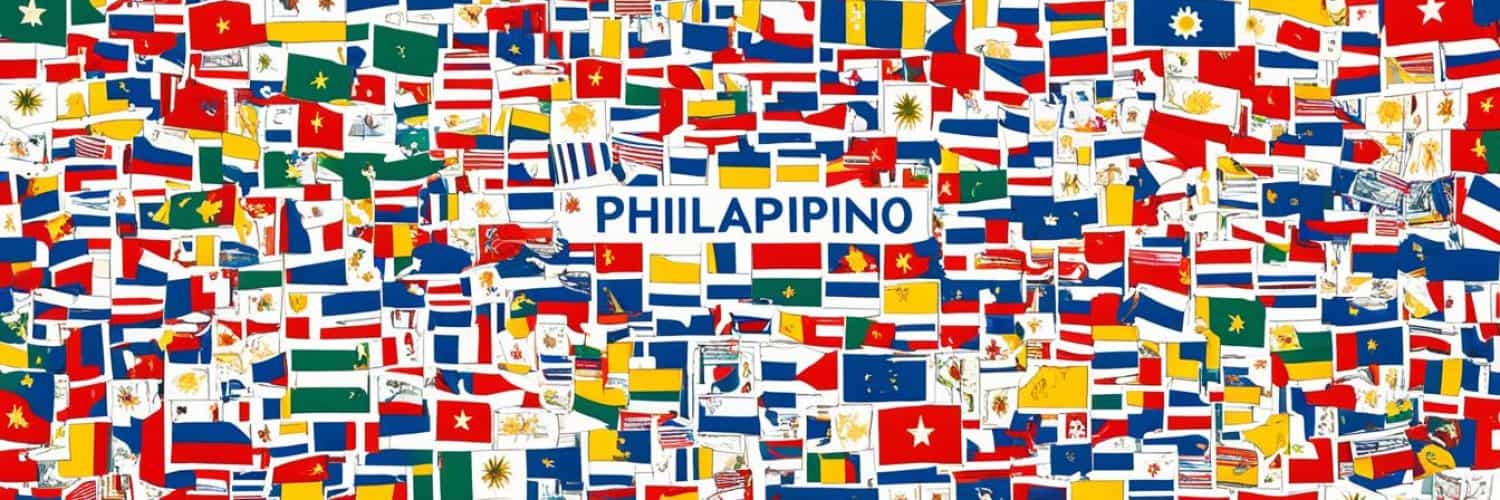What is the official language of the Philippines? Is it Filipino or English? What role does Tagalog have? If you’re curious about the Philippine languages and why Tagalog is important, you’re in the right place. In this article, we’re exploring the language essentials of the Philippines. We will look into the linguistic diversity, historical influences, and cultural significance of Tagalog and other regional languages. Join us on a journey to understand the beautiful country of the Philippines better.
Key Takeaways:
- The official languages of the Philippines are Filipino and English, but the most widely spoken language is Tagalog.
- The Philippines has a rich linguistic diversity with over 7,000 islands and 183 living languages.
- Learning Tagalog can lead to a deeper understanding of Filipino culture and enhance your travel experiences in the Philippines.
- The Spanish and American occupations have had a significant influence on the Filipino language.
- Embracing the language and culture of the Philippines can create meaningful connections with the Filipino people.
The History of the Philippines Language
The Philippines has a rich history of languages shaped by foreign influences. It’s key to understanding the country’s diverse culture and language.
The Spanish changed the Tagalog language a lot during their time in the Philippines. They made Spanish the official language, changing Tagalog’s words, grammar, and sound. In fact, almost half of Tagalog’s words come from Spanish.
The U.S. then took over, making English the main language. This change added to the country’s mix of languages.
Yet, Tagalog stayed important. In 1935, the Philippines chose Tagalog as the foundation for its national language. This move aimed to unite the country’s many ethnic groups.
Now, Tagalog, or Filipino, is the national language. It’s taught in schools and used officially. While English is also key, especially in business and schooling, Tagalog remains culturally vital. It’s part of the Philippines’ identity.
Learning about the Philippines’ language history shows how colonization and culture mix. It shows how the country’s language got its rich diversity.
The Linguistic Diversity of the Philippines
The Philippines is known for its rich language variety. Over 7,000 islands each have their own languages and dialects. This results in 183 living languages spoken across the country.
Some of the major languages include Tagalog, Cebuano, and Ilocano, among others. These languages stand out and add to the nation’s cultural richness.
Every region has its own mother tongue that shapes its culture. These languages show the unique history and traditions of the Filipino people.
Despite the many languages, Tagalog plays a key role in the country. It helps people from different areas communicate. It is used in government and as a common language.
Learning Tagalog
Are you interested in learning Tagalog? You’re in luck! It’s quite easy for beginners. The Latin alphabet forms the basis of modern Tagalog writing. This makes it familiar to those who speak English, helping you quickly learn the basics.
Pronunciation in Tagalog is direct. There are no silent letters. This makes it easier to read and speak. You can communicate better because each letter is pronounced.
Many resources can help you learn Tagalog. Glossika is one such resource. Glossika offers courses to improve your vocabulary, pronunciation, and sentence structure. It provides a thorough learning experience for all levels.
Learning Tagalog can deepen your appreciation of Filipino culture. It helps you connect with locals and immerse in Philippine traditions.
Benefits of Learning Tagalog
Learning Tagalog has many benefits. You can:
- Communicate better with locals while traveling
- Understand Filipino culture and traditions more deeply
- Forge meaningful friendships with native speakers
- Improve your travel experience in the Philippines
Start Your Tagalog Learning Journey Today
Ready to learn Tagalog? Start immersing yourself and practice often. Use resources like Glossika to boost your skills. With dedication, you’ll be fluent in no time.
| Resource | Description |
|---|---|
| Glossika | Offers Tagalog language courses to improve vocabulary, pronunciation, and sentence structure |
| Language learning apps | Provide additional support and practice exercises for learning Tagalog |
| Textbooks | Offer comprehensive lessons and exercises to help you progress in Tagalog |
| Language exchange programs | Allow you to practice Tagalog with native speakers and improve your conversational skills |
Common Tagalog Phrases for Travel
Traveling to the Philippines? It’s wise to know some common Tagalog phrases. They will help you in everyday conversations. This makes your visit more fun and lets you connect with locals. Here are essential Tagalog phrases to learn:
Greetings
Greet the locals in their own language to start off on the right foot:
- Musta – Hello
- Kamusta – How are you?
Basic Phrases
Being polite is important. Learn these key phrases:
- Salamat – Thank you
- Paalam – Goodbye
- Oo – Yes
- Hindi – No
Navigation and Directions
Knowing how to ask for directions is key when exploring:
- Saan ito? – Where is this?
- Saan ang simbahan? – Where is the church?
- Pwede bang magtanong? – Can I ask?
Emergency Phrases
Hopefully, you won’t need these. But it’s good to know emergency phrases:
- Tulong! – Help!
- Sakit ang tiyan ko. – I have a stomachache.
- Kailangan ko ng tulong. – I need help.
By learning these common Tagalog phrases, your Philippine adventure will be smoother. Locals will appreciate your efforts in using their language and culture. So learn these phrases and enjoy the beautiful Philippines!
Useful Phrases for Traveling Table
| English | Tagalog |
|---|---|
| Hello | Musta |
| How are you? | Kamusta |
| Thank you | Salamat |
| Goodbye | Paalam |
| Yes | Oo |
| No | Hindi |
| Where is this? | Saan ito? |
| Where is the church? | Saan ang simbahan? |
| Can I ask? | Pwede bang magtanong? |
| Help! | Tulong! |
| I have a stomachache. | Sakit ang tiyan ko. |
| I need help. | Kailangan ko ng tulong. |
Greetings and Etiquette in the Philippines
Filipinos are known for their warm hospitality and high regard for others. Greeting someone is a big part of their culture. Saying “Magandang araw,” which means “Good day” in Tagalog, is a popular way to start a conversation. It’s a respectful and friendly way to greet someone.
“Kumusta ka,” meaning “How are you?” is another common greeting in the Philippines. It shows you genuinely care about how the person is doing. Using this phrase helps build a connection.
There are also special customs to know when visiting the Philippines. “Mano po” is a traditional way to show respect to elders. You place your right hand on theirs and bring it to your forehead. This gesture, along with saying “Mano po,” shows deep respect. It’s a beautiful way to honor older people.
Knowing these greetings and customs makes it easier to connect with people in the Philippines. By respecting their way of life, you can make meaningful friendships. It’s a great way to experience their famous hospitality.

Filipino Greetings at a Glance
| Greeting | Meaning |
|---|---|
| “Magandang araw” | Good day |
| “Kumusta ka” | How are you? |
| “Mano po” | Greeting gesture to show respect to elders |
Major Languages in the Philippines
The Philippines is home to a rich variety of major languages. These include Tagalog, the national language, and several other languages. Each reflects the country’s diverse cultural heritage. They are deeply rooted in their regions and shape local identities.
Cebuano (Bisaya)
Cebuano, also called Bisaya, is widely spoken in the Philippines. It’s mainly used in the Visayas and Mindanao regions. Many people speak Cebuano, adding to the country’s linguistic diversity.
Hiligaynon
Hiligaynon, or Ilonggo, is mostly spoken in Western Visayas, like Iloilo. It stands out for its melodious sound and unique words. This makes it different from other Philippine languages.
Ilonggo
People often use Ilonggo to refer to Hiligaynon speakers. They are mostly in the Visayas and Mindanao. Ilonggo and Hiligaynon share many traits, being key to the Philippines’ cultural heritage.
Ilocano
Ilocano is mainly spoken in Northern Luzon’s Ilocos Region. It’s among the most spoken languages in the Philippines. Ilocano is famous for its rich literature and expressiveness.
Bicolano
Bicolano, or Bicol, is used in Luzon’s Bicol Region. It’s known for its rhythmic sound and metaphors. Bicolano is important for preserving cultural heritage.
Waray
Waray, or Waray-Waray, is spoken in Eastern Visayas, especially Samar and Leyte. Its unique pronunciation and vocabulary stand out. Waray speakers are a big part of the Philippine population.
Pangasinense
Pangasinense is used in Pangasinan, Ilocos Region. It’s notable for its lyrical sound and grammar. The language is vital for the province’s cultural identity.
Maguindanao
Maguindanao is spoken by the Maguindanao people in the Muslim Mindanao region. It’s linked to the region’s Islamic culture. The language is part of the Moro family.
Kapampangan
Kapampangan is spoken in Pampanga and parts of Tarlac, Bataan, and Nueva Ecija. Its phonetic sounds and vocabulary are unique. Kapampangan is crucial to Central Luzon’s culture.
The Philippines’ major languages highlight its vibrant linguistic diversity. Each language has its own story, traditions, and nuances. They add to the cultural richness of the country. Understanding and valuing these languages can enhance your connection to the Philippine people and places.
Language Influence from Spanish Colonization
The Spanish colonization of the Philippines changed the Tagalog language a lot. Nearly half of Tagalog words come from Spanish. This shows in vocabulary, grammar, and pronunciation. Spanish loanwords in modern Filipino language highlight the connection between Spain and the Philippines.
Spanish has greatly influenced Tagalog. Words like “silya” (chair), “kamay” (hand), and “kain” (to eat) show Spanish roots. Tagalog also uses Spanish grammar rules, like articles.
Spanish words in Filipino language show cultural exchange during colonial times. These loanwords make Tagalog richer and remind us of the link between the two countries.
Spanish loanwords are part of everyday Filipino language. Words like “kutsara” (spoon), “tenedor” (fork), and “mesa” (table) are used daily. They appear in both formal and informal talks.
The lasting impact of Spanish in the Philippines goes beyond words. It also touched cuisine, traditions, and customs. This influence shows the deep mark Spanish colonialism left on Filipino life.
Spanish loanwords connect the Philippines’ past with its present. They remind us of the cultural mix that makes Filipino identity so diverse and rich.
Language Influence from American Occupation
After taking over the Philippines, the United States made English the official language. This replaced Spanish. English has greatly shaped the Filipino language and aspects of Philippine society.
English is common in the Philippines, especially in cities and among educated people. It is key in education, used both for teaching and learning in schools. Being good at English is seen as important for career success.
English is also big in Philippine media and business. Newspapers, magazines, TV shows, and business dealings often use English. This makes information and fun stuff easy to get. It also helps in the global business world.
“English has become an integral part of Filipino culture and daily life. It has opened doors to opportunities and facilitated global connections.”
In the Philippines, knowing English is seen as prestigious. It often means you’re well-educated and can move up socially.
Yet, the Filipino language still thrives. Filipino and English are the nation’s official languages. Filipinos smoothly switch between English and Filipino, depending on who they’re talking to or where they are.
Importance of Learning Tagalog
Learning Tagalog helps if you are visiting or living in the Philippines. It makes chatting with locals easier. You’ll also get a better grasp of Filipino culture and traditions. This new skill can make your trips better, help you make friends, and allow cultural exchanges.
Knowing Tagalog lets you connect with Filipinos deeply. It shows you respect their culture. This can make strong friendships easier to build. In local markets, food stalls, or festivals, speaking Tagalog makes everything better.
Understanding Tagalog helps with daily tasks too. It’s useful for ordering food, asking for directions, or getting around. This confidence lets you explore more. You’ll truly experience the local lifestyle.
Learning Tagalog shows you value Filipino culture. It’s a sign of respect. Locals often respond well. They share more about their life and traditions with you.
To learn Tagalog, you can find many online tools. There are apps, websites, and courses. They cover basic vocabulary, grammar, and how to pronounce words. Practicing with native speakers or joining language exchanges can also help.
The benefits of learning Tagalog are huge. It helps you communicate and understand the culture. You’ll form real connections and have special experiences. Learning Tagalog is an adventure. It’s a way to show respect for the Philippines and its people.
Resources for Learning Tagalog
Learning Tagalog is fun and rewarding. Whether just starting or looking to get better, there are many tools to help you. They provide lessons, tools, and practice to improve your Tagalog skills effectively.
Online Platforms
Platforms like Glossika offer courses for different skill levels. These focus on vocabulary, pronunciation, and grammar. Glossika’s interactive lessons boost your confidence and communication skills.
Language Learning Apps
Apps like Duolingo and Rosetta Stone have Tagalog courses too. They make learning fun with exercises and quizzes. You can learn at your own speed and see how much you’ve improved.
Textbooks and Learning Guides
Books are great for learning on your own. “Complete Filipino (Tagalog) Beginner to Intermediate Course” by Living Language and “Tagalog for Beginners” by Joi Barrios are good examples. They have lessons and exercises to help you learn grammar, vocabulary, and about Filipino culture.
Language Exchange Programs
Language exchange programs are great for practice. They pair learners with native Tagalog speakers wanting to learn English or another language. This is a chance to talk with native speakers, become more fluent, and learn about Filipino culture.
Using these resources can speed up your learning. Be consistent, practice a lot, and dive into the language for the best results.

Language Challenges in the Philippines
The Philippines is rich in different languages, which can sometimes make communication hard for non-Tagalog speakers. Although many people speak English, there are areas where it’s not as common. This situation can lead to misunderstandings.
Yet, Filipinos are friendly and patient. They appreciate when visitors try to speak a little Tagalog. This effort helps overcome language barriers and connects visitors with locals.
Learning simple Tagalog phrases is very useful. It can help whether you’re ordering food, asking for directions, or just chatting. Trying to speak the local language shows you respect the culture. This can make your interactions smoother and more enjoyable.
Understanding Filipino culture and customs makes it easier to deal with language issues. Knowing basic greetings and gestures can really help you bond with locals.
While English is still key in the Philippines, learning the local language can enrich your experience. It allows for a real cultural exchange. You get to know the culture on a deeper level.
Embracing Language and Culture in the Philippines
Embracing the vibrant language and unique culture of the Philippines is key. By learning Tagalog and connecting with locals, you dive deep into the beauty of this diverse country. It helps you appreciate Filipino traditions more.
To really embrace the language, consider joining immersion programs. These programs offer intensive Tagalog lessons and cultural experiences. You’ll be surrounded by native speakers and local culture.
Cultural exchanges are another great way to connect. When you connect with Filipinos, they share their language and traditions with you. This enriches your understanding of the country.
Joining local community events is a wonderful way to dive deeper. These events let you experience traditional dances, taste authentic cuisine, and learn about the country’s history. By taking part, you celebrate with the locals and make lasting memories.
Through cultural immersion, you’ll understand the Filipino way of life better. Appreciating the Filipino language, like learning Tagalog phrases, connects you to the people. It makes your relationship with them more personal.
Embracing the language and culture of the Philippines opens doors to new friendships, meaningful connections, and a truly immersive travel experience.
So, why not start exploring Filipino language and culture? Immersive language programs, cultural exchanges, and vibrant community events await. Embracing these will enrich your travel experience and give you lasting memories.
The Cultural Immersion Experience
When immersing yourself in the Philippines’ language and culture, here are some tips:
- Take language classes or join immersive programs to learn Tagalog.
- Talk with locals to practice your language skills and learn about Filipino traditions.
- Take part in cultural exchanges and activities to connect deeper with the local community.
- Attend festivals and events to see traditional dances, music, and cuisine.
- Visit historical sites to learn about the country’s rich culture.
- Be open-minded and respectful to truly appreciate the language and culture.
Embracing the language and culture of the Philippines will transform your journey. It not only enhances your travel but also changes how you see the world.
| Benefits of Embracing Language and Culture in the Philippines |
|---|
| 1. Cultural Immersion: By embracing the language and culture, you immerse yourself in the Filipino way of life. This gives you a greater appreciation for their customs. |
| 2. Meaningful Connections: Talking with locals and joining in cultural activities helps you make meaningful friendships. These connections are more profound than typical tourist encounters. |
| 3. Enhanced Travel Experience: Learning Tagalog and engaging in cultural immersion makes your trip more enriching and memorable. |
| 4. Understanding and Respect: When you embrace the language and culture, it shows respect to the Filipino people. This leads to positive interactions and appreciation. |
| 5. Global Perspective: Embracing different cultures broadens your view of the world. It fosters a global mindset. |
Embracing the language and culture of the Philippines lets you connect deeply with its people. Through language immersion, cultural exchanges, and local events, you discover the true essence of the Philippines. This journey creates lifelong memories.
Language as a Gateway to the Filipino People
Language serves as a gateway to connect deeply with Filipinos. Trying to speak Tagalog shows respect for their culture. It breaks down barriers, fostering meaningful relationships beyond usual tourist scenes.
Embracing the language helps create lasting memories. Knowing basic Tagalog phrases opens doors to meaningful local interactions. Whether in busy cities or calm islands, you feel closer to the locals.
Learning the language diversifies your conversations with Filipinos. It expands your understanding of their culture and traditions. You share stories, ideas, and immerse in local culture, feeling a sense of belonging and friendship.
“Language is the road map of a culture. It tells you where its people come from and where they are going.” – Rita Mae Brown
Embracing the Filipino language shows deep respect for Philippine culture. It reveals your desire to connect beyond simple conversations. This act of learning mirrors your respect and love for their heritage.
Even a few words in Tagalog can make a big difference. It connects different cultures, creating friendship and understanding. While enjoying Filipino food, asking for directions, or shopping, speaking Tagalog transforms the experience.
Don’t hesitate to start learning the language. It’s your key to truly connecting with Filipinos. Discover the beauty of the Philippines and its people by speaking their language.
Travel Tips for the Philippines
When you plan your trip to the Philippines, remember some key language tips. Knowing basic Tagalog phrases can help a lot. You’ll better navigate daily life and connect with locals.
Language Tips
- Start by learning common greetings like “Magandang araw” (Good day) and “Kumusta ka” (How are you). These phrases can open conversations and leave a good impression.
- Saying “Salamat” (Thank you) to kind gestures is important. It shows gratitude, which Filipinos highly appreciate.
- Asking “Paano pumunta sa…” (How do I get to…) is very helpful for getting directions. It makes exploring new places easier.
- Being polite is important, so use “Po” (a term of respect) in your talks. It demonstrates respect to others.
- If something is unclear, don’t hesitate to ask for help. Filipinos are generally helpful and will appreciate your effort to speak Tagalog.
The local language is a big part of culture. Trying to learn and use it can deepen your connection with Filipino people.
Cultural Etiquette
Respecting cultural customs is crucial in the Philippines, along with language. Here are etiquette tips to remember:
“Mano po” is a sign of respect for elders in the Philippines. You do this by touching the back of their hand to your forehead. This gesture is much appreciated and shows respect for customs.”
Remember to dress modestly, especially in religious places or during cultural events. Adapting to local customs shows your respect for traditions.
Exploring Filipino Cuisine
Experiencing Filipino food is a must when you visit. Dishes like “Adobo,” “Sinigang,” and “Lechon” are delicious and unique. Trying local food is a great way to learn about Filipino culture.
Conclusion
The Philippines is rich in languages, with Tagalog as the national tongue. English is also widely spoken. But, knowing Tagalog can make your stay more rewarding. The country’s history with Spain and America has mixed cultures into its language.
Understanding the local language and culture connects you deeper to the Philippines. Even basic Tagalog helps in communicating and showing respect to the locals.
If you’re visiting or moving to the Philippines, diving into its language and culture is key. You’ll truly embrace the country’s diverse and captivating essence.







Add comment